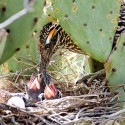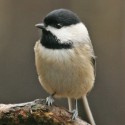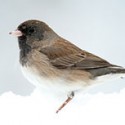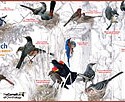 Photo ©
Keith Williams
Photo ©
Keith Williams

Elusive Roadrunner Captured on Film
Earlier this month, Doris Evans of Tucson, Arizona, submitted this photo of a Greater Roadrunner at the nest, with five chicks. This was the first photo of a roadrunner nest to have been submitted to NestWatch, so we thought we’d share! Doris says that to observe and photograph a pair of nesting Greater Roadrunners from her own yard “was an amazing experience.” She watched the pair building the nest, incubating the eggs, and raising five young.
Roadrunners often situate their nest in a thorny bush, small tree, or cactus 3–10′ high. The nest is usually located near the center of the thorny plant, and is well concealed. Among the more typical nest materials you might expect (twigs, grasses, feathers, and mesquite pods), you might also find snakeskin or dried cow manure.
Old nests are sometimes reused for a winter roost, something most cup-nesting birds don’t do. Another unusual thing about roadrunners is that both parents incubate the eggs. Males and females both develop a brood patch (a wrinkly patch of bare skin on the abdomen) that is used to transfer heat to eggs. The male takes the night shift because, unlike the female, his body temperature will remain constant all night, rather than drop to conserve precious energy.
Speaking of energy, the roadrunner diet is truly cosmopolitan. A startling variety of foods are taken, including some venomous species. Lizards (including horned lizards), snakes (even rattlesnakes), insects, spiders, scorpions, birds, bird eggs, and pet food are all fair game. To fully appreciate their dietary gusto, watch a video that Doris captured of the parents feeding a zebra-tailed lizard to a nestling that is scarcely bigger than the prey.
If you live in the southwestern United States, you might find a roadrunner nest by looking carefully in your thorny shrubs and cacti this winter. Occasionally, they will reuse a nest the next breeding season. Check out more of Doris’ photos to get your “search image,” and then go out and see what you find!

Why Do Some Birds “Try Harder” to Raise Young?
by Amos Belmaker
PhD candidate, Cornell Lab of Ornithology
Here in the Northeast, the breeding season of 2013 was a hard one. In Ithaca, New York, the poor nesting birds were hit by one storm after another. They barely had a day or two to recover and feed their chicks. I study Tree Swallows, which catch flying insects–if it’s cold and rainy, there are no insects and no food to bring home to the young ones. This season, mortality was high and my spirits were low.
But throughout this whole ordeal I kept noticing something interesting. While some birds were being hit hard, others didn’t seem that affected by it all. Of course, it was hard for them as well, but their chicks were fed and grew nicely and many fledged at the end of the season. Why the difference? How can some birds weather the storm just fine, while others, facing starvation, are forced to abandon the nest? They had access to the same food supply and the same weather, but it just seemed like some birds weren’t “giving it all they’ve got.” I started to think whether there was some biological basis to “giving it all you’ve got”, or “reproductive investment.” My dissertation work, which I’m doing under the supervision of Dr. David Winkler here at the Lab, focuses exactly on that question: What tells a Tree Swallow to invest more or less in reproduction?
I believe the answer is hiding in structures called telomeres, which protect the birds’ DNA (actually, people have them too). They shorten throughout life and, basically, anything the doctor tells you is bad for you is a telomere shortener. When telomeres get too short, they can’t do their job anymore and risk of death increases. So the shorter the birds’ telomeres, the less likely it is to survive. If a Tree Swallow is not going to live long, she might give the current breeding season “all she’s got” because the next one may never come. If she had longer telomeres, she could save energy for later, essentially hedging her bets against a bad year. (We don’t really know how birds perceive this shortening, but it may be in the form of hormone changes.)
Perhaps the birds who are working hard to make a bad year successful are those who have short telomeres and can’t afford to lose? I am still looking for evidence to support this intriguing idea. To do this, I add chicks to Tree Swallow boxes and give the parents a choice: keep investing normally and risk raising fewer chicks, OR increase investment at a survival cost to yourself. If I’m correct, then only short-telomere birds will rise to the challenge and fledge the additional chicks. Through my research, I am asking a very simple question with profound repercussions: What would a Tree Swallow do if it didn’t have much time left?

Still Accepting 2013 Data!
Chickadee-dee-dee! We just broke the record for the number of Carolina Chickadee nest attempts submitted in one year! Congratulations, NestWatchers, that’s 425 nests, and counting, this year.
We’re still accepting your 2013 data, so it’s not too late to enter it online. Although we can accept it in the future, it is important to enter your data as soon as possible so that we can summarize the year. The sooner you enter your data, the sooner it becomes available to scientists, so don’t wait! Submit your data online today at NestWatch.org. Need help getting started? Watch our data entry tutorial videos for step-by-step instructions.

Fundraising Update
We have reached 82% of our fundraising goal as of early December, thanks to your generosity! As we prepare for winter break and close the books on 2013, we hope you will consider NestWatch when you plan your year-end giving.
We steward your donations very carefully, making sure that your gift goes toward expanding our reach and scientific impact, not to overhead costs. We are grateful to everyone who has given so generously to NestWatch this year.

Monthly Winner
At the beginning of each month, NestWatch randomly selects one participant who has entered data that month to receive a copy of the NestWatch Common Nesting Birds of North America poster. This month’s lucky winner is John Bigham, Jr. Congratulations, John!